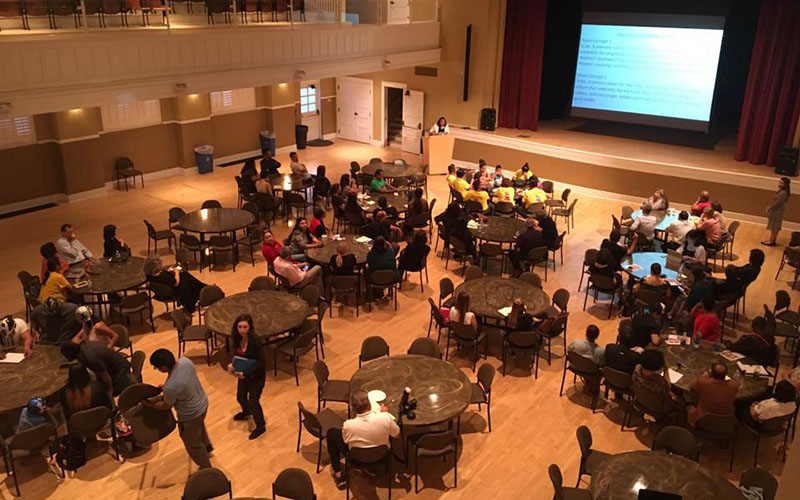
Attendees at one of the forums organized by the City of Phoenix to discuss the feasibility of a Latino Cultural Center. (Photo courtesy of Phoenix Office of Arts & Culture/Facebook)
PHOENIX — A recent report about the future of a proposed Latino cultural center in Phoenix found “a significant need” for the center, a place where local artists and community will have a voice in arts that reflect their heritage.
In 2001, a successful bond election set aside $1 million to renovate the Museo Chicano in downtown Phoenix. It closed eight years later, said Gail Browne, executive director of the Office of Arts and Culture in Phoenix, adding that city officials decided funding could be used for a new project that benefited the Latinos of Phoenix.
The report estimates the project will cost about $4 million.
“I think the ultimate goal would be to build a facility that has the flexibility and serves the need of the community,” Browne said.
Last year the city hired an outside firm, Evonne Gallardo Arts and Culture Management from Los Angeles, to make recommendations and produce a report about the center’s potential future. It also asked for community members to offer views about how a cultural center could serve them.
“There are a number of Latino arts and culture organizations here in Phoenix and we thought it would be helpful to bring in someone with an outside perspective in order to be completely unbiased and open-minded about all the resources that we have here,” Browne said.
In completing the report, Evonne Gallardo held town halls and forums, conducted online surveys and spoke personally with people in the local Latino art scene.
Browne said there is the possibility of starting a nonprofit that would eventually run the center.
The analysis found a “significant need for a Latino Cultural Center, most notably, to serve as a convener and support entity for existing Latino arts and cultural producers in Phoenix,” according to the report.
The report also identified a number of strengths and weaknesses in the Phoenix Latino Arts and Culture field and laid out what it is that people want from the cultural center.
Among the extensive list of what community members envision is a library with previously banned books from Latino authors and Afro-Latinx representation.
Arguing Amongst the City Council
Among those concerned about the cost and the report is Phoenix City Councilman Sal DiCiccio. Sam Stone, DiCicco’s chief of staff, said DiCiccio found the public input process “statistically deficient” and local artists influenced people to respond to the survey.
“If you hold a presidential preference poll on Breitbart.com, you’re going to get a preference for Trump, you’re going to get a huge preference for Trump that’s way out of scale with the national preference,” Stone said. “And they did essentially the same kind of thing.”
According to the data provided in the report, the town halls and focus groups were overwhelming Latino. In the electronic survey, 151 out of the 254 respondents identified as Latino as well.
Stone said Evonne Gallardo should’ve put together a plan that included a program or facility that already existed in Phoenix to achieve better cost efficiency. However, DiCiccio doesn’t oppose the idea of the Latino Cultural Center in general, Stone said.
“It’s the direction that they’re taking this that we disagree with,” he said. “It needs some very significant modification before he (DiCiccio) can support it.”
Councilwoman Laura Pastor vehemently disagrees.
“He (DiCiccio) was there every step of the way, he knew every bit that was happening,” she said. “We were as transparent as anything, as anyone could be in this whole process and there were many different voices that were part of the process.”
Local Arts Community Support
Laura Wilde, the executive director for Xico Inc., a Latino and indigenous arts organization, said it’s common knowledge the project has its financial risks.
“If this project does go through, we just need to ensure that it’s done well,” she said. “I think if the project were to happen and fail, it would be devastating for the city at large, but also incredibly devastating to the Latino community, and just a repeat of what has happened in the past.”
Wilde was a part of the Latino Advisory Committee that was consulted during the creation of the report, since early 2017.
“Evonne Gallardo has also taken on a very difficult task and has done really well with it,” Wilde said. “People are really invested in the project so there was a lot of brainstorming and talking about the benefits and the unique challenges as they relate to the Latino community.”
She said drumming up community support and fundraising for this project will be a challenge, but if it gets completed, she hopes the center can be both a beacon and a resource.
“I think it would be a wonderful place for the Latino community to feel at home and to have some ownership and stake in this community,” Wilde said. “There’s a rich cultural history that’s more than Dia de los Muertos, more than Frida Kahlo, more than skulls and all this kind of stuff, that I don’t think people really know about.”